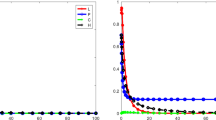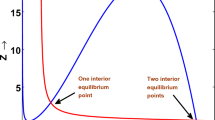Abstract
A reaction-diffusion model with logistic growth and constant effort harvesting is considered. By minimizing an intrinsic biological energy function, we obtain an optimal spatial harvesting strategy which will benefit the population the most. The symmetry properties of the optimal strategy are also discussed, and related symmetry preserving and symmetry breaking phenomena are shown with several typical examples of habitats.
Similar content being viewed by others
References
Alikakos, N., Bates, P.W., Chen, X.: Convergence of the Cahn-Hillard equation to Hele-Shaw model. Arch. Ration. Mech. Anal. 128(2), 165–205 (1994)
Block, B.A., Dewar, H., Blackwell, S.B., Williams, T.D., Prince, E.D., Farwell, C.J., Boustany, A., Teo, S.L.H., Seitz, A., Walli, A., Fudge, D.: Migratory movements, depth preferences, and thermal biology of Atlantic bluefin tuna. Science 293, 1310–1314 (2001)
Bates, P.W., Fife, P.C.: The dynamics of nucleating for the Cahn-Hilliard equation. SIAM J. Appl. Math. 53(4), 990–1008 (1993)
Brauer, F., Castillo-Chávez, C.: Mathematical Models in Population Biology and Epidemiology. Texts in Applied Mathematics, vol. 40. Springer, New York (2001)
Cantrell, R.S., Cosner, C.: Diffusive logistic equations with indefinite weights: population models in disrupted environments. Proc. R. Soc. Edinb. Sect. A 112(3–4), 293–318 (1989)
Cantrell, R.S., Cosner, C.: Spatial Ecology via Reaction-Diffusion Equation. Wiley Series in Mathematical and Computational Biology. Wiley, New York (2003)
Carr, J., Gurtin, M.E., Slemrod, M.: Structured phase transitions on a finite interval. Arch. Ration. Mech. Anal. 86(4), 317–351 (1984)
Chanillo, S., Grieser, M., Imai, M., Kurata, K., Ohnishi, I.: Symmetry breaking and other phenomena in the optimization of eigenvalues for composite membranes. Commun. Math. Phys. 214, 315–337 (2000)
Chanillo, S., Grieser, M., Kurata, K.: The free boundary problem in the optimization of composite membranes. Contemp. Math. 268, 61–81 (2000)
Clark, C.W.: Mathematical Bioeconomics, The Optimal Management of Renewable Resources. Wiley, New York (1991)
Du, Y., Shi, J.: A diffusive predator-prey model with a protection zone. J. Differ. Equ. 229(1), 63–91 (2006)
Fraenkel, L.E.: Introduction to Maximum Principles and Symmetry in Elliptic Equations. Cambridge University Press, Cambridge (2000)
Gurtin, M.E., Matano, H.: On the structure of equilibrium phase transitions with the gradient theory of fluids. Q. Appl. Math. 46, 301–317 (1988)
Harrell, E.M., Kröger, P., Kurata, K.: On the placement of an obstacle or a well so as to optimize the fundamental eigenvalue. SIAM J. Math. Anal. 33, 240–259 (2001)
Kurata, K., Shibata, M., Sakamoto, S.: Symmetry-breaking phenomena in an optimization problem for some nonlinear elliptic equation. Appl. Math. Optim. 50, 259–278 (2004)
Lieb, E., Loss, M.: Analysis. American Mathematical Society, Providence (1997)
Lou, Y., Yanagida, E.: Minimization of the principal eigenvalue for an elliptic boundary value problem with indefinite weight, and applications to population dynamics. Jpn. J. Ind. Appl. Math. 23(3), 275–292 (2006)
Murray, J.D.: Mathematical Biology. I. An Introduction, 3rd edn. Interdisciplinary Applied Mathematics, vol. 17. Springer, New York (2002)
Murray, J.D.: Mathematical Biology. II. Spatial Models and Biomedical Applications. Interdisciplinary Applied Mathematics, vol. 18. Springer, New York (2003)
Neubert, M.G.: Marine reserves and optimal harvesting. Ecol. Lett. 6, 843–849 (2003)
Ni, W.-M., Wei, J.: On the location and profile of spike-layer solutions to singularly perturbed semilinear Dirichlet problems. Commun. Pure Appl. Math. 48(7), 731–768 (1995)
Okubo, A., Levin, S.: Diffusion and Ecological Problems: Modern Perspectives, 2nd edn. Interdisciplinary Applied Mathematics, vol. 14. Springer, New York (2001)
Oruganti, S., Shi, J., Shivaji, R.: Diffusive logistic equation with constant yield harvesting. I: Steady states. Trans. Am. Math. Soc. 354(9), 3601–3619 (2002)
Shi, J., Shivaji, R.: Global bifurcation for concave semiposition problems. In: Goldstein, G.R., Nagel, R., Romanelli, S. (eds.) Advances in Evolution Equations. Proceedings in Honor of J.A. Goldstein’s 60th Birthday, pp. 385–398. Dekker, New York (2003)
Shi, J., Shivaji, R.: Persistence in reaction diffusion models with weak Allee effect. J. Math. Biol. 52(6), 807–829 (2006)
Skellam, J.G.: Random dispersal in theoretical populations. Biometrika 38, 196–218 (1951)
Author information
Authors and Affiliations
Corresponding author
Rights and permissions
About this article
Cite this article
Kurata, K., Shi, J. Optimal Spatial Harvesting Strategy and Symmetry-Breaking. Appl Math Optim 58, 89–110 (2008). https://doi.org/10.1007/s00245-007-9032-7
Received:
Accepted:
Published:
Issue Date:
DOI: https://doi.org/10.1007/s00245-007-9032-7




